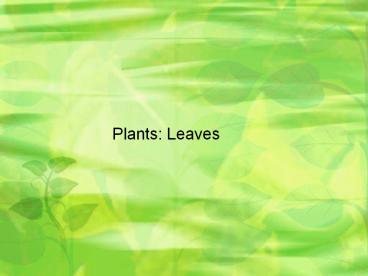Plants: Leaves - PowerPoint PPT Presentation
1 / 9
Title:
Plants: Leaves
Description:
Plants: Leaves Leaves Play role in photosynthesis, gas exchange, storage, and protection from predators. Leaf cells absorb energy from sunlight in a chloroplast which ... – PowerPoint PPT presentation
Number of Views:180
Avg rating:3.0/5.0
Title: Plants: Leaves
1
Plants Leaves
2
Leaves
- Play role in photosynthesis, gas exchange,
storage, and protection from predators. - Leaf cells absorb energy from sunlight in a
chloroplast which contains photopigments. - Photopigments are chemicals that absorb
particular wavelengths of red and blue light and
reflect green light.
3
Leaf Structure
- Make sugar and supplies all living organisms with
food and oxygen - Designed so they can capture the most amount of
sunlight. - Covered with a waxy cuticle that is produced by
the epidermis. Both provide protection. - Stomata are little passages on the underside of
leaves that allow for gas and water vapour
exchange. Woody plants have no stomata on the
upperside, herbaceous plants do have stomata on
the upperside. - Stomata are open during the day and closed at
night
4
- Carbon dioxide is used by chloroplasts to perform
photosynthesis - Carbon dioxide is brought into the plant through
the stoma, while oxygen and water are released
into the atmosphere. - Photosynthesis cannot happen at night, so the
stomata are closed. - Each stoma is surrounded by two guard cells that
are kidney-shaped, specialized epidermal cells
with chloroplasts - Water moves into the guard cells during the day
because of all the ions that move into the cells. - The inside is thicker, so the outside can expand
more, creating a hole between the two cells.
5
- Cells within the leaf are the mesophyll cells
that have a lot of chloroplasts and have two
layers - Palisade layer that are densely packed and have
more chloroplasts - Spongy layer that are loosely spaced so air can
come in contact with the cells. - Water loss from the leaves through evaporation is
called transpiration - The xylem and phloem continue from the stems into
the leaves in special vascular bundles called
veins. - Monocot veins run parallel to each other
- Dicot veins run in a branching network
6
(No Transcript)
7
Leaf Specializations
- Dry climate thicker cuticle, stomata on
underside. - Cactus leaves are modified into spines
- Aquatic plants have stomata on the upperside for
gas exchange. - Onion bulb stores water and carbs
8
Leaf Uses
- Provide important nutrients and food energy in
the diets of humans. - Use them for herbs and spices
- Teas
- They are nutritious (calcium, potassium, iron,
magnesium, vitamins B, C, E, K) - Use waxy cuticle for polishes, cosmetics,
candies.
9
Leaves and Chemicals
- Leaves produce chemicals that humans have used in
the past and present as medicinal. - Research one medicinal plant and report on what
it is used for as homework tonight































